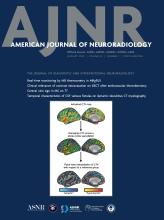Abstract
BACKGROUND AND PURPOSE: Impaired glymphatic function has been suggested to be implicated in the pathophysiology of MS and aquaporin-4 immunoglobulin G-positive neuromyelitis optica spectrum disorder. This study aimed to investigate the interstitial fluid dynamics in the brain in patients with myelin oligodendrocyte glycoprotein antibody disorders (MOGAD), another demyelinating disorder, using a noninvasive imaging technique called the diffusivity along the perivascular space (ALPS) index.
MATERIALS AND METHODS: A prospective study was conducted on 16 patients with MOGAD in remission and 22 age- and sex-matched healthy control subjects. MR imaging was performed using a 3T scanner, and the ALPS index was calculated using diffusion MR imaging data with a b-value of 1000 s/mm2. The ALPS index and gray matter volumes were compared between the 2 groups, and these parameters were correlated with the Expanded Disability Status Scale.
RESULTS: The mean ALPS index of patients with MOGAD was significantly lower than that of healthy controls (Cohen d = 0.93, false discovery rate–corrected P = .02). The lower mean ALPS index was significantly associated with a worse Expanded Disability Status Scale score (Spearman ρ = −0.51; 95% CI, −0.85 to −0.02; P = .03). However, cortical volume and deep gray matter volume were not significantly different between the 2 groups, and they were not correlated with the Expanded Disability Status Scale.
CONCLUSIONS: This study suggests that patients with MOGAD may have impaired glymphatic function, as measured by the ALPS index, which is associated with patient disability. Further study is warranted with a larger sample size.
ABBREVIATIONS:
- ALPS
- diffusivity along the perivascular space
- EDSS
- Expanded Disability Status Scale
- FA
- fractional anisotropy
- FDR
- false discovery rate
- IgG
- immunoglobulin G
- MOG
- myelin oligodendrocyte glycoprotein
- MOGAD
- myelin oligodendrocyte glycoprotein antibody disorders
- NMOSD
- neuromyelitis optica spectrum disorder
- QRAPMASTER
- quantification of relaxation times and proton density by multiecho acquisition of a saturation-recovery by using turbo spin-echo readout
- © 2024 by American Journal of Neuroradiology
Indicates open access to non-subscribers at www.ajnr.org












